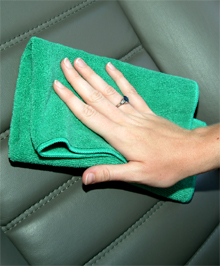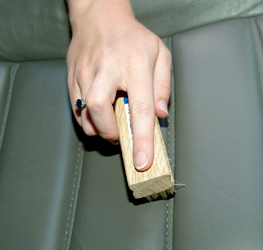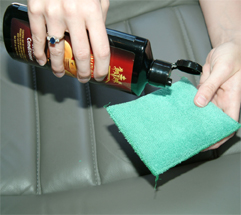We see an awful lot of cars in this business, traveling as we do to auctions, concours, car shows, national conventions and neighborhood cruise nights. The only way to rise to the top of the heap among all the other nice cars out there is to be absolutely obsessive about detailing a car. A top-quality, well-planned detail job can turn a twenty-footer into a standout when it comes time to pick up the trophies, or wring those last few dollars out of a potential bidder at auction.
We spent hours on the phone and online with experts around the country, learning their secrets and applying them to our own nasty cars, in the hopes of making them look a little more presentable for shows, and for everyday driving as well. When it gets right down to it, attention to detail and frequency of a proper cleaning make the job a lot easier when you really have to do it.
Everything we're showing here we've tried ourselves. We've also gotten tips from George Mattar (our own on-staff professional detailer). He ran his own detailing business for decades and had hundreds of happy clients.
We've learned a lot, and we thought we'd break it all down into manageable bites. We hope you'll pick up a few pointers you can use to keep your own car at the top of its game.
Photo 1: Eric Eadington of Flawless Auto in Newport Beach, California, gave us the cardinal rule of detailing: "The final finish is 90 percent in the prep," he says. "The most common misconception is that a wash and wax will give a show-car shine." Hey, I think we've heard that rule before, and it was the same for painting a car.
Photo 2: Everyone we talked to had this piece of advice: READ THE DIRECTIONS. Every product is different, and how you apply it can mean the difference between a satisfying experience and a huge letdown. Take three seconds and read the back of the package.
Photo 3: We'll warn you right up front: Get a password to
Autopia.org and you're going to be spending a lot of "work time" surfing around looking for killer detailing tips. It's a great Web site populated by both professional detailers and folks who just like to have ultra-clean cars. Anything you should know, you'll definitely find here.
Photo 4: You know how to wash your car, right? We thought so, too, but we've recently been using the two-bucket method, and we'll never go back. Get yourself two buckets, and fill one with plain rinse water, and one with your soap and water solution. We got these two ten-gallon buckets for free from a local company that makes batteries. As you're washing, rinse your wash mitt or brush in the rinse bucket before you pick up soapy water. It will float the grit out of your mitt and not grind it back into the paint.
Photo 5: French chefs call it "mise en place" or "everything in its place." It refers to everything you need for a particular job being laid out in a place where you can reach it. We laid out all of our items on a wheeled cart so that we could roll it around the garage a bit easier. We also started with wheel cleaner on the right and worked our way through the job to the left to keep all of our chemicals separate.
Photo 6: Clay bars have been the secret domain of pro detailers and bodyshops for years. We spoke to Mike Pennington at Meguiar's, and he noted that as long as you start with the least aggressive clay and keep the painted surface lubricated with a spray detailer (even a mild solution of carwash and water will work), there's nothing you can do to harm your paint. You'll feel it take surface contaminants right off the paint.
Photo 7: Here's what we mean when we say "swirl marks." They appear when a fine bit of grit is placed between your wash mitt, wax applicator or chamois cloth and the painted surface. Eric Eadington sent us these before and after shots of a Dinan M5 he had in his shop. Removing them requires patience, some swirl remover and a dual-action buffer.
Photo 8: For really nasty swirls, you're going to have to call in the reinforcements. If you can't find a dedicated swirl remover at your local parts house, check your phone book for an auto body supply store in your area.
Photo 9: The tool on the bottom is a Porter Cable dual-action buffer. The yellow one on the top is a DeWalt variable speed polisher. One you could hold on the paint for half an hour and not do anything too bad. The other could grind the paint off a battleship in half a second. Learn the difference. (Hint: buy a dual-action buffer and leave the polisher to the pros.)
Photo 10: Autopia.org regular Steve Mynott had this killer glass-cleaning tip: Wipe the glass in vertical strokes on the outside, and horizontal strokes inside. That way, if you have a streak, you'll know what side of the glass it's on.
Photo 11: We're going to warn you right now: This stuff is addictive. Sprayway is like the Krispy Kreme donut of glass cleaners. First off, it leaves an absolutely streak-free shine on the glass. Second, it stays put, unlike most glass cleaners that dribble all over the place the second they leave the bottle. And third, they haven't invented a sexier scent since the damp mimeograph sheets Mrs. Walsh used to hand out in third grade. Yummy.
Photo 12: There are three basic levels of wheel cleaners on the market today, which we've ordered from least aggressive to most aggressive. Read the directions and know what you're about to spray on your wheels. And don't forget that whatever you're spraying on the wheels is also going to be sprayed all over the brake calipers, rotors and suspension parts, too. Better to start cleaning your wheels with nothing more than carwash soap and water, and work your way up.
Photo 13: Stainless steel trim can get seriously oxidized from years of acid rain and other contaminants. We cleaned up Mike's trim with a bit of Mother's Mag and Aluminum Wheel polish, and got jiggy with a wad of #00 steel wool. Be sure to try it on an inconspicuous area, though. Like on the car next to yours.
Photo 14: Places where you rest your arm or hand (like your steering wheel, shift knob, or armrest) are guaranteed to be the nastiest places in your interior. Managing Editor Mike McNessor's 1983 Mercedes 300 SD was pretty grungy inside when he bought it, so we hit it with a heavy-duty interior cleaner (Meguiar's #39 we bought at a car show), and scrubbed it lightly with a toothbrush. You couldn't find nastier stuff inside the Fry-O-Later vent at Burger Whopper.
Photo 15: Whenever you use a harsh (usually marked "Heavy Duty") interior cleaner, be sure to apply something afterward that has some UV protection.
Photo 16: Mark your microfiber towels to indicate what they're for. Mark several with "G" for "Glass" and don't use them for anything else. Don't even wash them with your other towels, because wax will impregnate itself into the fibers and you'll never get them to clean the glass the same way.
Photo 17: WD-40 or a similar lubricant is an excellent bug and tar remover, and about as cheap a solvent as you can find. Just be sure to rewax any portion of the car you cleaned with it.
Photo 18: This is a product called Optimum No Rinse Wash and Shine. For those of you living in water-restricted neighborhoods, or those of you who hate the idea of blowing 50 gallons of water every time you wash your car, you can get a pretty effective wash done with just a gallon of wash water and a gallon of rinse water. The idea is that it very effectively floats the dirt off the paint without requiring gallons of rinse water.
Photo 19: Jeremy Bingham from Perfect Finish in Indianapolis, Indiana, sent us a great tip: For interior cleaning, use a solution of six parts water and one part Woolite. "It's very gentle, and it works wonders," he says.
Photo 20: We took Jeremy's suggestion, but we picked up an off-the shelf solution: Woolite Oxy Deep. We had a blue ink stain on a rear floormat and the stuff took it out with no discoloration of the mat. Amazing.
Photo 21: Mike's Benz had a spot of pine sap deposited on the hood around the time of Ronald Reagan's first inauguration. We hit it with a little isopropyl alcohol from the medicine cabinet. It'll take some rubbing compound and a buff to get that spot out. Better to carry some spray detailer and a microfiber towel with you and take care of it immediately.
This article originally appeared in the July, 2006 issue of Hemmings Sports & Exotic Car.Order Backissues of Hemmings Sports & Exotic Car |
Subscribe to Hemmings Sports & Exotic Car
(from: http://www.hemmings.com/hsx/stories/2006/07/01/hmn_feature1.html)











 Many popular
conditioners, like
Many popular
conditioners, like